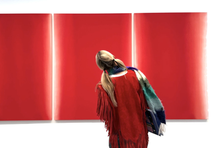Impressionists in London
- The Courtauldian
- Nov 20, 2017
- 2 min read

Claude Monet, Leicester Square, 1901. Oil paint on canvas, 805 x 648 mm. Fondation Jean et Suzanne Planque (in deposit at Musée Granet, Aix-en-Provence) Photo: © Luc Chesse
Tate Britain’s new exhibition seems to provide the Impressionist’s vision of gloomy London. With the exhibition’s subtitle being ‘French artists in exile 1870 – 1904’, the exhibition goes on to explore different aspects of French artists in London, at different time periods and for different reasons.
After an introduction, the exhibition shows how specific artists, who might rather not be associated with Impressionism, developed in their new environment. This is followed by thematic approaches, which are ‘Sports, Parks and Crowds’ and ‘Fogs, the Thames and Westminster’. The fascinations of these French artists are evident, for example, Pissarro’s illumination of a rainy day in an illuminated green park. Whistler highlights the nostalgic atmosphere of the Thames with cold and blue tones next to Giuseppe De Nittis’ violent and sinister depiction in red. The following rooms consider the artist’s depictions of London. Monet’s shimmering and dazzling vision along the Thames around 1900 are elusive scenes of well-known places, transformed through countless colours.
As the exhibition considers many different themes with different approaches, this makes it feel like no theme is developed in sufficient depth. It leaves one with questions such as: did the Impressionists change our view of London? Did London change the view of the Impressionists? Was there an impact of the British art world on French artists? There are examples, but the exhibition simply seems to run too quickly through its too large lining of thematic considerations. There are French artists in exile in London, French Impressionists in exile in London, Impressionists in London and French artists in London. Going from one to another, the exhibition seems to be unable to unify the artists into one coherent approach through the interesting theme of location and movement for artistic creation. In these rooms, whether considered in the context which the exhibition sets out or not, are however the Impressionist’s or French artists’ visions of London, which show well known places in a different light, colours and moods. Therefore, it is worth to go in with one’s own searching eye.
Impressionists in London runs until 7 May 2018 at Tate Britain.












Comments